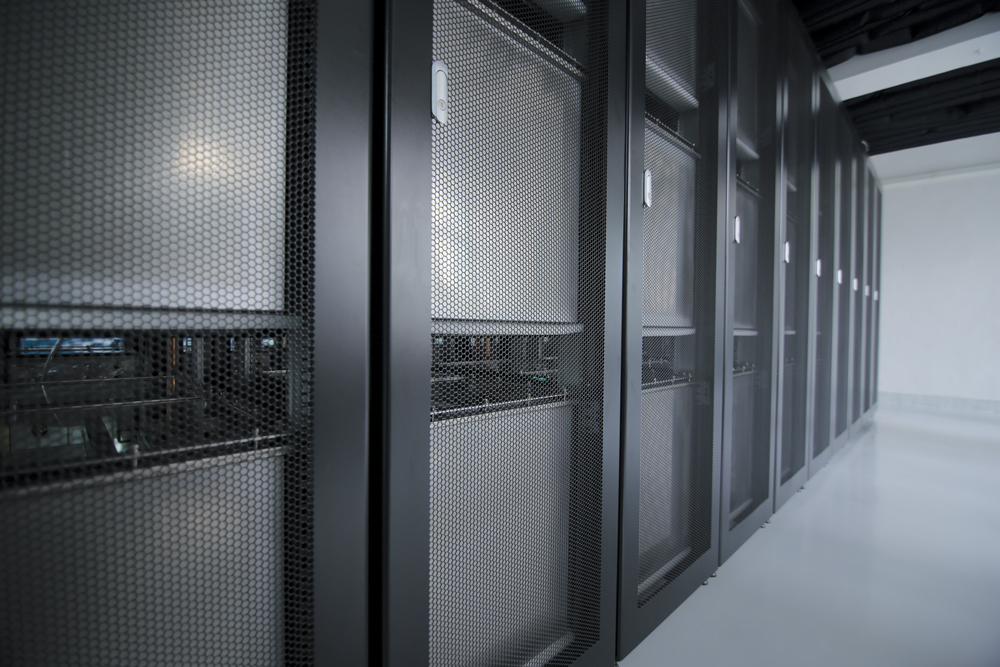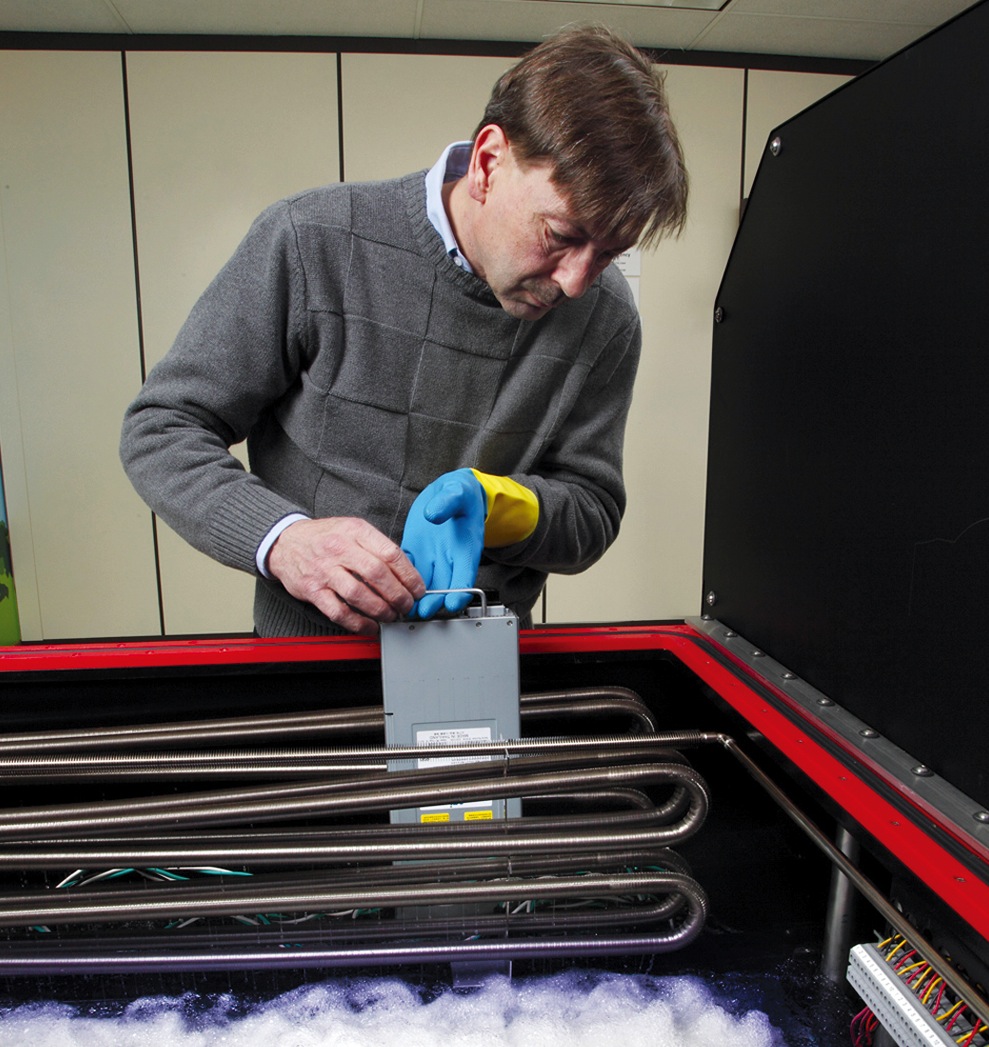In the rush to slash energy consumption in power-hungry data centers, design teams, equipment manufacturers, and tech companies have been developing clever, low-energy cooling solutions—from Facebook’s open-rack server setup with exposed motherboards, to Skanska’s eOPTI-TRAX liquid refrigerant coil system, to Google’s evaporative cooling schemes.
Solutions like these have helped data center facility operators achieve unprecedented energy performance levels, with power utilization effectiveness (PUE) ratios dipping below 1.10 in some instances. This means that less than 10% of the total energy consumption in a facility is attributed to noncomputing functions, such as air-conditioning and lighting.
Now, a new technology promises to push the limits of data center energy efficiency even further. Called immersive cooling, it uses a liquid instead of air to cool the servers. LiquidCool Solutions, Green Revolution, and 3M are among the pioneers of this technology. Each system works a bit differently, but the basic idea is to submerge the motherboards in tanks filled with nonconductive fluid, which absorbs the heat generated by the processors.
LiquidCool Solutions, for example, uses an enclosed server module and pumps dielectric fluid through the server enclosure. Green Revolution uses a tub full of dielectric oil and circulates the liquid through the tubs. 3M also uses the tub approach, but the fluid boils and then is condensed to reject the heat.
By using liquid-based cooling at the server level, the need for air-conditioning is greatly reduced, or even eliminated in some climates. The same goes for traditional HVAC equipment and systems—chillers, fan units, raised floors, and so on.

The Allied Control 500 kW immersion-cooled data center in Hong Kong is capable of delivering a PUE of just 1.02. The standard, 19-inch server racks use 3M Novec Engineered Fluids to enable tight component packaging for greater computing power in less space, according to Allied. Its open-bath design permits easy access to hardware and eliminates the need for pressure vessel enclosures and charging/recovery systems. PHOTO: COURTESY ALLIED CONTROL
“In most parts of the world, compressorized cooling would not be required with immersive cooling, since the liquid temperatures can be at a level where direct heat rejection using outdoor condensers or cooling towers would be sufficient,” says Thomas Squillo, PE, LEED AP, Vice President with Environmental Systems Design, who is currently researching the technology for the firm’s data center clients. “The fan energy is also eliminated, both in the HVAC system and in the server itself. Fluid pumping energy is very low.”
Other advantages of the cooling technology, according to Squillo:
• Increased performance and service life of the computer chips by eliminating heat buildup and problems related to contaminated air and dust.
• Ability to deploy data centers in extremely harsh environments without greatly impacting energy performance.
• Potential construction cost savings by downsizing or eliminating traditional HVAC systems.
Other than a few pilot projects, including a Bitcoin mining data center in Hong Kong and a Lawrence Berkeley National Laboratory-led installation in Chippewa Falls, Wis., immersive cooling technology is largely untested. A year into the Bitcoin pilot, the data center operator reported a 95% reduction in cooling costs.
AEC professionals are starting to realize the potential for immersive cooling, especially for high-performance computing centers and consolidated, high-density data centers.
“Large data centers that have many homogenous machines at high density—like those operated by Internet and cloud providers—are a good application,” says Squillo. “Small footprint and minimal energy use are very important due to the volume of servers. These can be deployed in remote areas where space and energy are cheap, but where air quality may be a concern, without having to worry about the data center air.”
TRICKY DESIGN CONSIDERATIONS
Before the technology can be implemented, says Squillo, several nettlesome design factors specific to immersive cooling have to be addressed:
• Piping distribution to the racks and cooling units requires redundancy and valving to accommodate equipment maintenance without disrupting server performance.
• Additional equipment and space are needed to drain fluid from the tanks for server maintenance.
• Local code requirements may limit the amount of fluid that can be stored in a single room.
• For the foreseeable future, it’s unlikely that a large data center would be 100% liquid-immersion cooled. This means provisions will have to be made for both air- and liquid-cooling systems, which will require additional space in the data hall and mechanical room.
“I think that some form of this technology will definitely be the direction the data center market will take in the future,” says Squillo. “The market just needs to mature enough for owners to trust the technology and demand servers that are designed for a particular type of liquid cooling. In the short term, I see large companies and server manufacturers doing small-scale installations to test the concept, before wanting to implement it at a large scale.”
Related Stories
K-12 Schools | May 15, 2024
A new Alabama high school supports hands-on, collaborative, and diverse learning
In Gulf Shores, a city on Alabama’s Gulf Coast, a new $137 million high school broke ground in late April and is expected to open in the fall of 2026. Designed by DLR Group and Goodwyn Mills Cawood, the 287,000-sf Gulf Shores High School will offer cutting-edge facilities and hands-on learning opportunities.
Adaptive Reuse | May 15, 2024
Modular adaptive reuse of parking structure grants future flexibility
The shift away from excessive parking requirements aligns with a broader movement, encouraging development of more sustainable and affordable housing.
Affordable Housing | May 14, 2024
Brooklyn's colorful new affordable housing project includes retail, public spaces
A new affordable housing development located in the fastest growing section of Brooklyn, N.Y., where over half the population lives below the poverty line, transformed a long vacant lot into a community asset. The Van Sinderen Plaza project consists of a newly constructed pair of seven-story buildings totaling 193,665 sf, including 130 affordable units.
K-12 Schools | May 13, 2024
S.M.A.R.T. campus combines 3 schools on one site
From the start of the design process for Santa Clara Unified School District’s new preK-12 campus, discussions moved beyond brick-and-mortar to focus on envisioning the future of education in Silicon Valley.
University Buildings | May 10, 2024
UNC Chapel Hill’s new medical education building offers seminar rooms and midsize classrooms—and notably, no lecture halls
The University of North Carolina at Chapel Hill has unveiled a new medical education building, Roper Hall. Designed by The S/L/A/M Collaborative (SLAM) and Flad Architects, the UNC School of Medicine’s new building intends to train new generations of physicians through dynamic and active modes of learning.
Sustainability | May 10, 2024
Perkins&Will’s first ESG report discloses operational performance data across key metrics
Perkins&Will recently released its first ESG report that discloses the firm’s operational performance data across key metrics and assesses its strengths and opportunities.
MFPRO+ News | May 10, 2024
HUD strengthens flood protection rules for new and rebuilt residential buildings
The U.S. Department of Housing and Urban Development (HUD) issued more stringent flood protection requirements for new and rebuilt homes that are developed with, or financed with, federal funds. The rule strengthens standards by increasing elevations and flood-proofing requirements of new properties in areas at risk of flooding.
Government Buildings | May 10, 2024
New federal buildings must be all-electric by 2030
A new Biden Administration rule bans the use of fossil fuels in new federal buildings beginning in 2030. The announcement came despite longstanding opposition to the rule by the natural gas industry.
Sustainable Development | May 10, 2024
Nature as the city: Why it’s time for a new framework to guide development
NBBJ leaders Jonathan Ward and Margaret Montgomery explore five inspirational ideas they are actively integrating into projects to ensure more healthy, natural cities.
Mass Timber | May 8, 2024
Portland's Timberview VIII mass timber multifamily development will offer more than 100 affordable units
An eight-story, 72,000-sf mass timber apartment building in Portland, Ore., topped out this winter and will soon offer over 100 affordable units. The structure is the tallest affordable housing mass timber building and the first Type IV-C affordable housing building in the city.

















